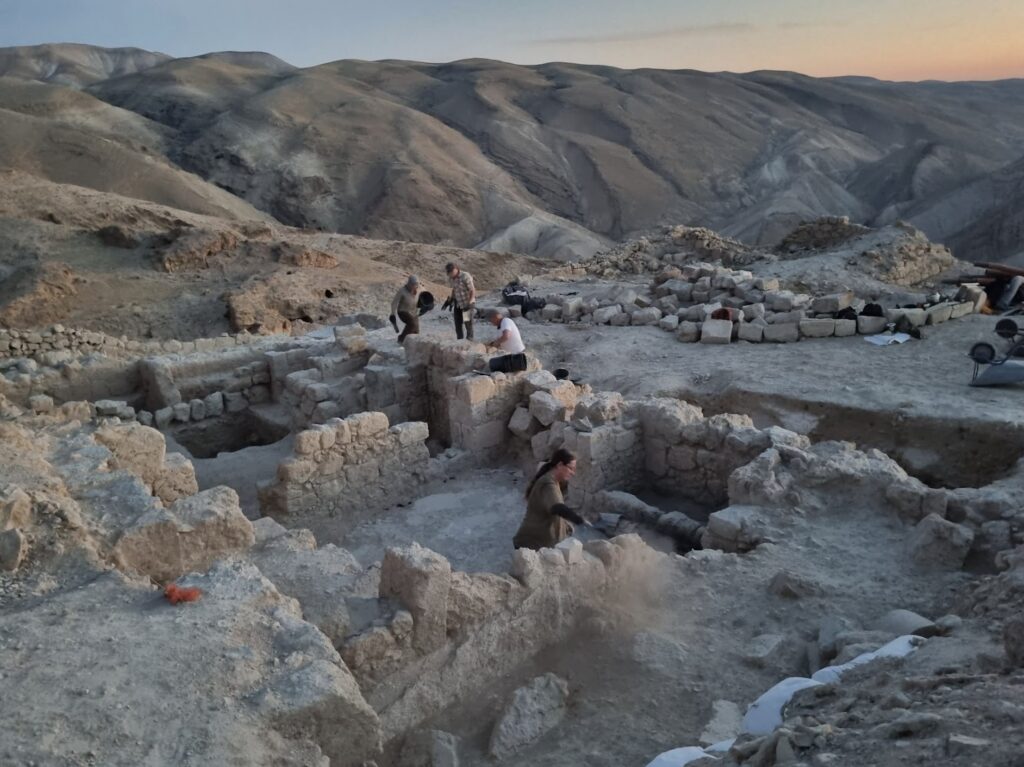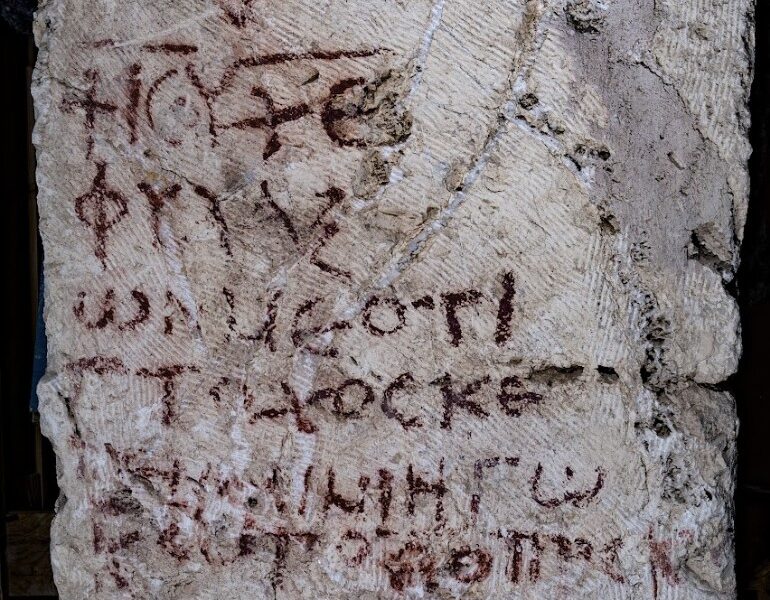A rare inscription paraphrasing part of Psalm 86 in the Greek used in the New Testament has been unearthed by a team of Hebrew University archaeologists working at the Hyrcania Fortress, a Second Temple-era structure situated atop a forbidding hilltop in the Judean Desert, about 17 kilometres southeast of Jerusalem.
A community of Byzantine Christian monks founded in the 5th century CE is likely responsible for the adapted Psalm 86 inscription. Dr. Avner Ecker of Bar-Ilan University, who helped decipher the inscription, noted that the writing contains small grammatical errors, indicating that “the priest was not a native Greek speaker, but likely someone from the region who was raised speaking a Semitic language.”
The 2023 Hyrcania excavation was directed by Dr. Oren Gutfeld and Michal Haber of the Hebrew University, in conjunction with Carson-Newman University (Tennessee) and American Veterans Archaeological Recovery, a program that uses archaeology to help US armed forces veterans transition back to civilian life.
In addition to the psalm adaptation, a similar inscription was found nearby, which is still awaiting analysis. The archaeologists noted these are probably the only Koine Greek Psalm inscriptions ever found on stone, as opposed to on parchment or other materials.
The university said the pilot dig, which took place earlier this year, was the first “methodological, academic archaeological excavation” undertaken at the site. Previously, the site had a few short visits by European archaeologists, the last of note being in the 1950s when a Belgian archaeologist, after being led to the site by Bedouins, discovered a trove of papyrus documents. Jordan controlled the area at the time.
The most famous and luxurious of these strongholds are Masada and Herodium. Shortly after the latter's death in 4 BCE, Hyrcania lost its importance and was abandoned. It would then lie desolate for nearly half a millennium until the establishment of a small Christian monastery among its ruins in 492 CE by the monk Holy Sabbas, an expression of the monastic movement that took shape in the Judean Desert with the rise of the Byzantine period.
Dubbed Kastellion, or “Little Castle” in Greek, the monastery remained active past the Islamic conquest of Byzantine Palestine around 635 CE but was apparently abandoned by the early 9th century. The site is known also by its Arabic moniker, Khirbet el-Mird, or “Ruins of the Fortress.” Attempts were made in the 1930s to revive the monastery, but harassment by local Bedouins cut short the venture.
Although a few isolated site investigations had been sporadically undertaken in the past, no methodological, academic archaeological excavation had ever been conducted—until now. Complex access and logistics have long played a role. However, recently, a team led by Hebrew University’s Dr. Oren Gutfeld and Michal Haber, with the support of Carson-Newman University (Jefferson City, Tennessee) and American Veterans Archaeological Recovery, spent four weeks at the site, uncovering key evidence of the site’s remarkable history.
During this initial “pilot” season, efforts focused on two key areas. In the southeastern corner of the summit, a segment of the prominent upper fortification line was uncovered, a vital component of the Second Temple-period fortress dating back to approximately the late 2nd or 1st century BCE. This discovery prompted Dr. Oren Gutfeld to observe: “Certain architectural elements within these fortifications strongly recall those of Herodium, all part of Herod’s extraordinary vision. It’s quite possible that the same engineers and planners even oversaw the construction. It’s not by chance that we call Hyrcania ‘Herodium’s little sister.’”
In the northeast, the team peeled away a deep collapse layer of building stones to unearth an elongated hall lined with piers, part of the lower level of an expansive compound constructed of finely drafted stones. Its original date of construction has yet to be determined, though it likely comprised part of the monastery.

Over the course of excavation, a sizeable building stone was discovered lying on the plastered floor of the hall, bearing lines of text painted in red, with a simple cross at its peak. Haber and Gutfeld immediately recognized the inscription as written in Koine Greek—the language of the New Testament—but called on their colleague, expert epigraphist Dr. Avner Ecker of Bar-Ilan University, to decipher it.
Dr. Ecker identified the readable text as a paraphrase of Psalms 86: 1–2, known as “a prayer of David.” While the original lines are “Hear me, Lord, and answer me, for I am poor and needy. Guard my life, for I am faithful to you,” the Hyrcania version reads:
† Ἰ(η)σοῦ Χ(ριστ)ὲ
φύλαξ<ο>ν με ὅτι
[π]τ<ω>χὸς (καὶ) [π]έν[ης] <εἰ>μὶ <ἐ>γώ† Jesus Christ, guard me, for I am poor and needy.
Dr. Ecker explains, “This psalm holds a special place in the Masoretic text as a designated prayer and is notably one of the most frequently recited psalms in Christian liturgy. Thus, the monk drew a graffito of a cross onto the wall, accompanied by a prayer with which he was very familiar.” Judging by the epigraphic style, he assigns the inscription a date within the first half of the 6th century CE. Ecker also points out the presence of a few grammatical errors typical of Byzantine Palestine, which can be attributed to individuals whose native language was a Semitic one. He suggests, “These minor errors indicate that the priest was not a native Greek speaker, but likely someone from the region who was raised speaking a Semitic language.”
A few days after this initial discovery, an additional inscription was found nearby. It was also inscribed on a building stone from a collapsed wall and is currently undergoing analysis.
Michal Haber emphasizes the profound significance of these findings, stating, “Few items hold such importance in the historical and archaeological record as do inscriptions—and it must be stressed that these are virtually the first examples from the site to have originated in an orderly, documented context. We are familiar with the papyrus fragments that came to light in the early 1950s, but they are all shaky, unreliable provenance. These recent discoveries are truly exceptional.”


